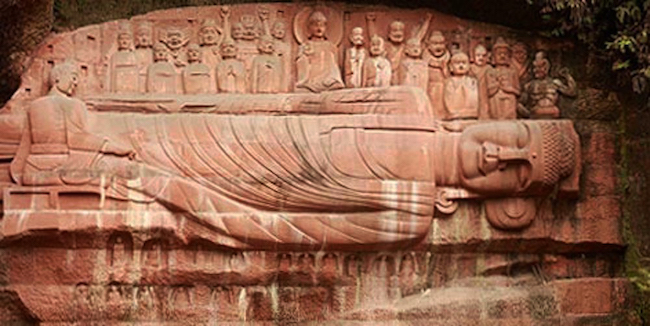POSTCARD#412: Some of the chief sources of emotional pain are called the ‘worldly winds’: the gusts of Praise and Blame, Gain and Loss, Fame and Ignominy, Happiness and Unhappiness. These impressions trigger demand, anxiety and despair wherein we never feel good enough where and how we are. And like winds, they can blow through the heart at gale force and throw us completely off balance.
Take for example how powerful the experience of Praise and Blame can be! We can hunger for praise… even a little crumb of approval now and then. Then you feel jealous if somebody else is getting huge amounts of praise, and you are standing by the door, hardly noticed. As for blame, how we wriggle and contort to try to avoid it! We aspire to being liked, and we work at it, but still somebody doesn’t like us. Or maybe we blame ourselves.
The Buddha made a very helpful summary of blame: ‘They blame one who remains silent, they blame one who speaks much, they blame one who speaks in moderation. There is no one in this world who is not blamed’ (Dhp. 227). That applied to him, too, for the Buddha was blamed many times. So when we know it’s inevitable we can just focus on doing our best, all the time keeping our wisdom-ear cocked for the mind’s yearning for approval and its dread of disapproval.
Once the mind starts to even anticipate being blamed, a flurry enters into it. And when the blaming begins … our mind may try to come up with a rational explanation for whatever it was we’re being blamed for, rather than simply feeling where the blame is digging in and then drawing a line around it: ‘This is painful mental feeling.’ It’s a trigger, so we need to be extremely patient with that feeling.
Patience has to be learned by focusing on that painful feeling and not reacting. It’s a humbling lesson: to feel the pain, be patient with it and learn something about letting it pass through. Feel the impression in the heart and don’t shrug it off, don’t fight back, don’t go under. An impression is an impression. Don’t rely on it, don’t adopt it, don’t try to avoid it. Instead, understand it for what it is.
Then you can see the truth about someone blaming you. You made a mistake? Is there something you can learn from this? And you can see the truth about someone praising you. How much good will praise do for you? Doesn’t it deprive you of privacy? And that surge that you feel from gain… doesn’t it make you vulnerable to loss? These winds are there to teach you patience. Focus on how patience feels and value it. Then you can acknowledge specific mistakes you’ve made without taking on the sense of being a failure. And you can experience others’ gratitude or praise with a sense of gladness that they have received something of benefit. You don’t have to own it.
Learning the True Response
For an achievement that will provide long-lasting nourishment, we have to develop a response to unsatisfactoriness, dukkha. The Buddha’s encouragement was that dukkha must be understood. The unsatisfactory, inconclusive, never-quite-fitting, things going- wrong, unstable quality has to be understood in order to realize the place where it ceases. And in order to understand, we have to ‘stand under’ that unsatisfactoriness. We don’t pole-vault over it to the nice bit on the other shore. Instead, we stand under it as it cascades over us. When there is a complete standing-under, we feel the quality of that flood. You look to where things touch you, where things are felt.
You look at physical pain and see what that does to you. First of all you wriggle a bit to find a way to soften it; then you begin to get a little annoyed by it; then you get very annoyed by it. You think, ‘It’s not fair this is happening to me.’ Then you think, ‘Oh, I give up.’ But still it hasn’t gone. It didn’t go because you haven’t really given up; you were waiting for it to end, so you’ve only given up ninety percent. Eventually, it pushes you into a corner, and the only thing you can do is accept its presence and work on your reactions.
In that full allowing of conditions to be what they are, we stabilize our hearts and find peace. It’s like putting a boat into water. We make an ark of truth: ‘Conditions are like this,’ and in that truth, we don’t adopt the conditions as our own. This is important: you can’t drain the sea, but you don’t have to drown.
Why we feel overwhelmed, as if we’re drowning, is because the heart is ‘leaky.’ When it isn’t secure, perceptions and feelings flood in and cause it to sink. But even then it’s just mind-stuff — no sights, sounds, physical pains or harsh words, just the impressions of those. It is these impressions that mount up to a sense of overwhelm and alienation. And the heart can recycle them for years, even when their apparent external source has long disappeared.
These perceptions, moods and reactions arise dependent on the mind’s expectations, fragility or aims. We have to learn deeply that the approval of others, the success in our career, and the presence of what we love are not to be taken as given, not to be adopted as mine. This adopting of conditions is what knocks holes in our boat. But when these conditions can be held in the truth of their nature, the mind lets go and senses a freedom that doesn’t depend on supports. Gain, loss, praise, blame — you don’t have to go under. You can wear out the reflex of hanging on to the world. But for this you have to be very patient.
(The ten perfections, continued next week 26 march 2021)











You must be logged in to post a comment.